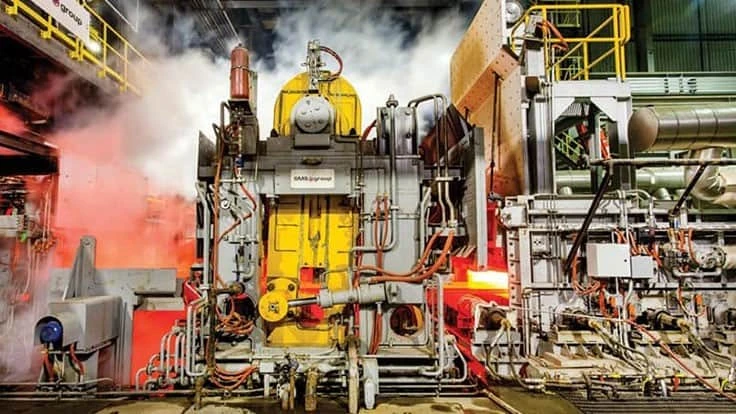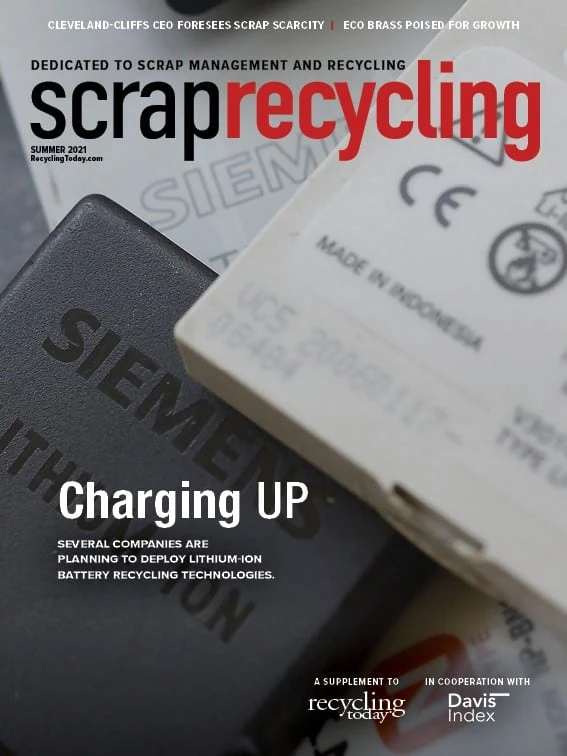
Photo courtesy of Big River Steel


Steel mills in the U.S. are slated to bring roughly 7.5 million net tons of capacity for hot-rolled, slab and plate steel online during the next 24 months. Some recently commissioned plants also have begun to ramp up capacity this year.
Demand for scrap and metallics is expected to grow with steel production. For example, adding nearly 10 million net tons of flat-rolled steel capacity likely will grow demand for prime scrap and scrap alternatives by more than 7 million net tons, says Phil Gibbs, an equity research analyst who focuses on the steel sector at KeyBanc Capital Markets, Cleveland.
A two-pronged issue
The expanded capacity can be viewed in two ways for minimills, Gibbs says. On the one hand, it will place downward pressure on finished steel pricing, which is at historical highs as of the second quarter of this year. It also will add a procurement challenge. On the other hand, the rise in demand for prime scrap will lift scrap prices in a tight supply environment. As finished steel prices decline, narrowing the profit margin for these steel producers, scrap prices are projected to adjust slightly downward. However, demand will buoy prices and limit pricing declines for all grades of ferrous scrap, especially prime material.
Scrap is anticipated to move extensively across regions to meet this growing demand, with most steel mills and many scrap yards established along water access points for barge and ship deliveries as well as along rail lines. Market participants note higher springboard shipments at premium prices for obsolete grades, which support regional scrap yard prices. For example, Big River Steel buys that drew from supplies in the Southeast and Midwest supported scrap prices over recent months.
Boost for scrap prices
Unlike additional bar mill capacity, which faces no shortage of obsolete scrap, sheet mill chemical compositions require higher quality raw materials. The electric arc furnace (EAF) mix for sheet consists of 60 percent prime scrap grades, 20 percent pig iron and 20 percent obsolete grades. Thus, demand for prime grades will increase prices for that material given the rise of EAFs in the country. At a minimum, with no incremental direct-reduced iron (DRI), hot briquetted iron (HBI) and pig iron sources domestically, minimills will further disaggregate from local sources and actively increase imports of prime scrap and metallics.
Prime scrap has limited sources domestically, and as the European Union increases its environmental shifts and EAF installations, prime scrap exports from that region could become limited in the near term.
In the U.S., Gibbs indicates, mills consume about 20 million metric tons, or 22 million short tons, of low-residual metallics, with approximately 40 percent, or 8.8 million tons, being imported. Mills import nearly 10 percent, or 2.2 million short tons, of prime scrap grades annually. The additional sheet capacity is slated to increase these import volumes.
In 2020, the U.S. imported 3.6 million metric tons (3.97 million short tons) of ferrous scrap, according to U.S. Census data. By category, No. 1 bundles were 30 percent of total imports, followed by 20 percent consisting of other high-grade ferrous scrap and 17 percent shredded steel scrap. The fourth-highest import was shavings and stampings, which is considered a clean grade, at 8 percent.
Comparatively, in the first two months of 2021, the U.S. imported 720,318 metric tons (794,000 short tons) of ferrous scrap, up 75 percent compared with the 412,374 metric tons (454,600 short tons) imported in the same two months of 2020. The largest source was Canada, which supplied 77 percent of imports in the first two months in 2021, followed by the U.K. and the EU.
In 2020, Canada’s imports tallied 2.6 million metric tons (2.87 million short tons), or 72 percent of total ferrous imports, with the most significant imports being No. 1 bundles, other higher grade ferrous scrap and shredded steel scrap.
To date, Mexico has been a limited source of ferrous scrap imports into the U.S. In 2020, imports from that country were estimated at 241,898 metric tons (267,000 short tons), or 7 percent, but 43 percent of those imports were categorized as shavings.
With Steel Dynamics Inc.’s (SDI’s) OmniSource division finishing the acquisition of the Mexican scrap processor Zimmer S.A. de CV in early August 2020, that unit will support SDI’s raw material procurement for the company’s Sinton, Texas, steel mill. The former Zimmer’s six scrap operations and three third-party processing locations are located strategically near high-volume industrial scrap sources in Mexico. The former Zimmer locations have about 2 million gross tons of processing capacity and were shipping about 500,000 gross tons, primarily within northern Mexico, allowing for substantial growth capacity.
Market participants report that SDI’s raw material buyers have been approaching industrial sources throughout Texas. Sinton is approximately three to four hours from major scrap yards near Houston and six to seven hours from those in Dallas.
SDI alone is estimated to require 1.5 million gross tons of prime and 500,000 gross tons in obsolete scrap annually once high utilization is achieved.
Koch Metallics LLC, Wichita, Kansas, is the exclusive procurement agent for Big River Steel. Lynn White, commercial development manager at Koch, says her company is leveraging relationships within Koch’s infrastructure for alternative raw materials. Sources will include demolition projects and end-of-life asset acquisitions domestically and internationally.
Widening spreads
Market participants agree that prime scrap will become tighter and maintain a considerable spread against obsolete grades, including shredded, heavy melt and structural. In the week of April 23, the spread between busheling and Midwest hot-rolled coil was above $900 per gross ton. In April ferrous trading, depending on region, the spread between No. 1 busheling and shredded trended at $150 to $220 per gross ton in transactions.
The pace of increases in ferrous scrap pricing has started to slow down, with the latest April ferrous trading week seeing obsolete grades tick downward by $20 per gross ton but remaining predominantly sideways for prime scrap. May is anticipated to trade sideways against April settled prices across all grades.
The overall expectation is that prime scrap, which has traditionally traded at an average price of $400 per gross ton delivered to mill, will remain in the range of $540 per gross ton delivered in 2021 and, despite post-COVID-19 supply chain balances, will stay elevated at nearly $475 per gross ton in 2022.
Increased demand in overall scrap volumes also is expected to keep average prices for shredded scrap higher at $423 per gross ton delivered in 2021, with a slight downward adjustment to an average of $395 per gross ton in 2022, close to the previous average for the better busheling grade.
Metallics rising
SDI has engaged Voestalpine’s HBI plant in Corpus Christi, Texas, for materials sourcing. Cleveland-Cliffs’ Ohio-based HBI facility will play a role possibly all the way to SDI in Texas, but volumes primarily are expected to support additional capacity throughout the Midwest.
Nucor’s production of DRI at its 2-million-metric-ton (2.2- million-short-ton) Trinidad and Tobago plants, and 2.5-million-metric-ton (2.76-million-short-ton) Louisiana plant are expected to play a growing role in the company’s supply chains at new facilities. Use of natural gas-based DRI, which reduces energy consumption and supports environmental objectives, will grow.
A need for alternative iron ore units facilitated by metallics also is necessitated by the degradation of existing prime scrap, and scrap grades in general, as steel is continuously recycled.
Pig iron imports also are projected to increase with the rise in sheet steel capacity in the U.S. as the tide turns to a more optimistic buying outlook. Pig iron import prices closely are trending No. 1 busheling prices.
Gibbs adds that, over time, supply and demand, along with innovation, will play a role in managing prices. Thus, the baseline prices of metallics likely will decrease as iron ore prices trend down from the present high and technologies, such as hydrogen, come online and gain efficiencies.
Iron ore prices are at about $170 per metric ton now and could be reduced by half in the next two years to average $80 to $85 per metric ton cost and freight (CFR) China. Prices are expected to normalize below $100 per metric ton CFR as China continues expanding its sources in Africa and Australia.
China is projected to continue its iron ore use as it produces 85 percent of its steel via blast furnaces, but any downward adjustments from a shift to EAF-based steel production would support global scrap demand and shift iron ore usage for metallics production. Demand for metallics in the U.S. also could motivate construction of sites worldwide.
The Mexico connection
Mexico also is adding steelmaking capacity that will place pressure on North American scrap supplies. ArcelorMittal is adding 2.75 million metric tons (3.03 million short tons) annual capacity at its Lázaro Cárdenas hot-strip mill in Michoacán in the second half of 2021. Ternium plans to commission a hot-rolling mill with 4.5 million metric tons (4.96 million short tons) annual production capacity in Pesquería, in northern Mexico, by July 2021, with adequate capacity utilization by late in year.

Explore the Summer 2021 Scrap Recycling Issue
Check out more from this issue and find your next story to read.
Latest from Recycling Today
- Phoenix Technologies closes Ohio rPET facility
- EPA selects 2 governments in Pennsylvania to receive recycling, waste grants
- NWRA Florida Chapter announces 2025 Legislative Champion Awards
- Goldman Sachs Research: Copper prices to decline in 2026
- Tomra opens London RVM showroom
- Ball Corp. makes European investment
- Harbor Logistics adds business development executive
- Emerald Packaging replaces more than 1M pounds of virgin plastic





